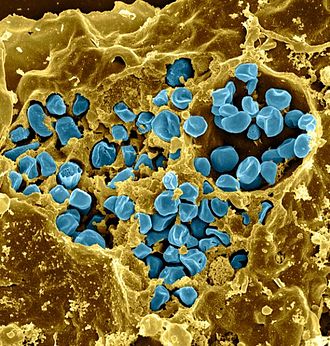What is Francisella tularensis ?

The highly contagious and sometimes lethal bacterium Francisella tularensis is the source of tularemia, a zoonotic illness that can afflict both people and animals. Given its high infectivity and potential for aerosol transmission, this bacterium is considered a Category A bioterrorism agent and requires a full study of its biology.
Table of Contents
Morphology
Gram-negative coccobacillus: Under a microscope, F. tularensis appears as tiny, round-to-oval-shaped bacteria that frequently resemble cocci.
Pleomorphic: It can change shape and size, which makes identification difficult.
Non-motile: It is immobile since it does not have flagella.
Facultative intracellular: F. tularensis may proliferate and persist in phagocytic cells, such as macrophages, which aids in the pathophysiology of the disease.
Culture Characteristics of Francisella tularensis
Aerobic or facultative anaerobic :Whether facultatively anaerobic or aerobic, they can thrive in situations with low oxygen levels but develop best in the presence of it.
Slow-growing: Culture grows slowly, requiring specialized media and taking three to five days to manifest.
Francisella needs enriched media such as buffered charcoal yeast extract (BCYE) agar or cysteine-glucose-blood agar in order to grow.
Optimal growth temperature : 37°C (98.6°F) is the ideal temperature for their growth.
Special features related to biochemistry: Francisella is recognized for being susceptible to lysozyme and for lacking catalase, oxidase, and urease activity.
Pathogenesis
Transmission
There are several ways that F. tularensis enters the body, including:
Inhalation: Airborne spread caused by tainted aerosols.
Skin contact: Coming into close proximity to diseased animals or their corpses.
Tick bite :The most frequent method of infection, especially in endemic areas, is tick bites.
Ingestion: Water or food contaminated.
Cellular invasion
F. tularensis enters the body, multiplies inside macrophages, and stays one step ahead of the host’s immune system.
Immunological evasion
The bacteria have the ability to inhibit the immunological response by suppressing the cytokine and chemokine production.
Clinical manifestations
Depending on the infection route, F. tularensis can cause a variety of symptoms.
Ulceroglandular: The most prevalent type, marked by enlarged lymph nodes and an excruciating ulcer at the entrance site.
Glandular: Enlarged lymph nodes that do not have ulcers.
Pneumonic: A severe case of pneumonia that may cause respiratory failure.
Typhoidal: fever, widespread weakness, and flu-like symptoms.
Oculoglandular: Eye infection resulting in enlarged lymph nodes and conjunctivitis.
Diagnosis
Culture :F. tularensis is isolated through culture from clinical materials.
Serology: Analyzing blood for F. tularensis antibodies.
Polymerase chain reaction (PCR) :Using the polymerase chain reaction (PCR), clinical specimens’ F. tularensis DNA is amplified.

Immunofluorescence assay: F. tularensis antigen detection in specimens using the immunofluorescence test.
Treatment
Antibiotics

Timely administration of antibiotics is essential for effective treatment:
streptomycin: The recommended medication in severe situations is streptomycin. Gentamicin: An additional potent treatment for serious infections. Doxycycline: Often used to treat tularemia in less severe types. An alternate antibiotic in certain situations is ciprofloxacin.
Supportive care
For patients with severe pneumonia, treatment options may also include oxygen therapy and symptom control.
Preventive measures of Francisella tularensis
Tick control: Steer clear of tick-infested regions, use protective gear, and periodically check for ticks.
Proper Wildlife handling : Wildlife handling best practices include keeping a safe distance from sick or dead animals, wearing gloves while handling carcasses, and fully cooking meat
Vaccination: For people who are particularly vulnerable, such as laboratory workers, there is a live attenuated tularemia vaccination.
Importance of Diagnosis and Treatment of Francisella tularensis
Early diagnosis is critical :Timely diagnosis is of the essence as it can considerably mitigate the severity of tularemia and avert consequences.
Early antibiotic therapy: Receiving antibiotics is essential for both survival and the avoidance of long-term consequences.
Concern for public health: F. tularensis is a serious threat that necessitates constant monitoring and preparation.
Conclusion
The bacteria that causes tularemia, F. tularensis, is extremely contagious and can be lethal. Comprehending the morphology, culture properties, pathogenesis, diagnosis, and therapy of this zoonotic disease is crucial for prompt intervention and efficient management. Timely diagnosis, suitable antibiotic treatment, and preventative actions are essential for maintaining patient welfare and reducing hazards to the public’s health.
Frequently Asked Questions(FAQ)
What is Francisella tularensis ?
The highly contagious and sometimes lethal bacterium Francisella tularensis is the source of tularemia, a zoonotic illness that can afflict both people and animals. Given its high infectivity and potential for aerosol transmission, this bacterium is considered a Category A bioterrorism agent and requires a full study of its biology.
List the Importance of Diagnosis and Treatment of Francisella tularensis ?
The Importance of Diagnosis and Treatment of Francisella tularensis,
Early diagnosis is critical :Timely diagnosis is of the essence as it can considerably mitigate the severity of tularemia and avert consequences.
Early antibiotic therapy: Receiving antibiotics is essential for both survival and the avoidance of long-term consequences.
Concern for public health: F. tularensis is a serious threat that necessitates constant monitoring and preparation.
Related Articles




